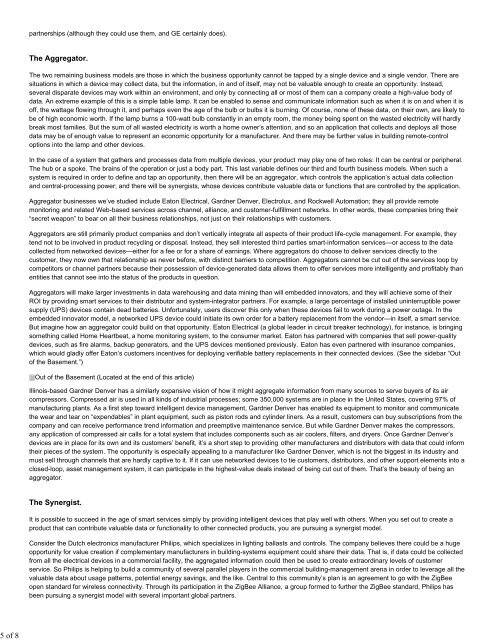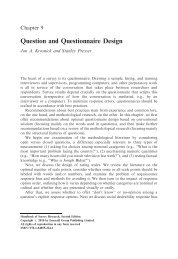Four Strategies for the Age of Smart Services - Courses
Four Strategies for the Age of Smart Services - Courses
Four Strategies for the Age of Smart Services - Courses
You also want an ePaper? Increase the reach of your titles
YUMPU automatically turns print PDFs into web optimized ePapers that Google loves.
5 <strong>of</strong> 8<br />
partnerships (although <strong>the</strong>y could use <strong>the</strong>m, and GE certainly does).<br />
The Aggregator.<br />
The two remaining business models are those in which <strong>the</strong> business opportunity cannot be tapped by a single device and a single vendor. There are<br />
situations in which a device may collect data, but <strong>the</strong> in<strong>for</strong>mation, in and <strong>of</strong> itself, may not be valuable enough to create an opportunity. Instead,<br />
several disparate devices may work within an environment, and only by connecting all or most <strong>of</strong> <strong>the</strong>m can a company create a high-value body <strong>of</strong><br />
data. An extreme example <strong>of</strong> this is a simple table lamp. It can be enabled to sense and communicate in<strong>for</strong>mation such as when it is on and when it is<br />
<strong>of</strong>f, <strong>the</strong> wattage flowing through it, and perhaps even <strong>the</strong> age <strong>of</strong> <strong>the</strong> bulb or bulbs it is burning. Of course, none <strong>of</strong> <strong>the</strong>se data, on <strong>the</strong>ir own, are likely to<br />
be <strong>of</strong> high economic worth. If <strong>the</strong> lamp burns a 100-watt bulb constantly in an empty room, <strong>the</strong> money being spent on <strong>the</strong> wasted electricity will hardly<br />
break most families. But <strong>the</strong> sum <strong>of</strong> all wasted electricity is worth a home owner’s attention, and so an application that collects and deploys all those<br />
data may be <strong>of</strong> enough value to represent an economic opportunity <strong>for</strong> a manufacturer. And <strong>the</strong>re may be fur<strong>the</strong>r value in building remote-control<br />
options into <strong>the</strong> lamp and o<strong>the</strong>r devices.<br />
In <strong>the</strong> case <strong>of</strong> a system that ga<strong>the</strong>rs and processes data from multiple devices, your product may play one <strong>of</strong> two roles: It can be central or peripheral.<br />
The hub or a spoke. The brains <strong>of</strong> <strong>the</strong> operation or just a body part. This last variable defines our third and fourth business models. When such a<br />
system is required in order to define and tap an opportunity, <strong>the</strong>n <strong>the</strong>re will be an aggregator, which controls <strong>the</strong> application’s actual data collection<br />
and central-processing power; and <strong>the</strong>re will be synergists, whose devices contribute valuable data or functions that are controlled by <strong>the</strong> application.<br />
Aggregator businesses we’ve studied include Eaton Electrical, Gardner Denver, Electrolux, and Rockwell Automation; <strong>the</strong>y all provide remote<br />
monitoring and related Web-based services across channel, alliance, and customer-fulfillment networks. In o<strong>the</strong>r words, <strong>the</strong>se companies bring <strong>the</strong>ir<br />
“secret weapon” to bear on all <strong>the</strong>ir business relationships, not just on <strong>the</strong>ir relationships with customers.<br />
Aggregators are still primarily product companies and don’t vertically integrate all aspects <strong>of</strong> <strong>the</strong>ir product life-cycle management. For example, <strong>the</strong>y<br />
tend not to be involved in product recycling or disposal. Instead, <strong>the</strong>y sell interested third parties smart-in<strong>for</strong>mation services—or access to <strong>the</strong> data<br />
collected from networked devices—ei<strong>the</strong>r <strong>for</strong> a fee or <strong>for</strong> a share <strong>of</strong> earnings. Where aggregators do choose to deliver services directly to <strong>the</strong><br />
customer, <strong>the</strong>y now own that relationship as never be<strong>for</strong>e, with distinct barriers to competition. Aggregators cannot be cut out <strong>of</strong> <strong>the</strong> services loop by<br />
competitors or channel partners because <strong>the</strong>ir possession <strong>of</strong> device-generated data allows <strong>the</strong>m to <strong>of</strong>fer services more intelligently and pr<strong>of</strong>itably than<br />
entities that cannot see into <strong>the</strong> status <strong>of</strong> <strong>the</strong> products in question.<br />
Aggregators will make larger investments in data warehousing and data mining than will embedded innovators, and <strong>the</strong>y will achieve some <strong>of</strong> <strong>the</strong>ir<br />
ROI by providing smart services to <strong>the</strong>ir distributor and system-integrator partners. For example, a large percentage <strong>of</strong> installed uninterruptible power<br />
supply (UPS) devices contain dead batteries. Un<strong>for</strong>tunately, users discover this only when <strong>the</strong>se devices fail to work during a power outage. In <strong>the</strong><br />
embedded innovator model, a networked UPS device could initiate its own order <strong>for</strong> a battery replacement from <strong>the</strong> vendor—in itself, a smart service.<br />
But imagine how an aggregator could build on that opportunity. Eaton Electrical (a global leader in circuit breaker technology), <strong>for</strong> instance, is bringing<br />
something called Home Heartbeat, a home monitoring system, to <strong>the</strong> consumer market. Eaton has partnered with companies that sell power-quality<br />
devices, such as fire alarms, backup generators, and <strong>the</strong> UPS devices mentioned previously. Eaton has even partnered with insurance companies,<br />
which would gladly <strong>of</strong>fer Eaton’s customers incentives <strong>for</strong> deploying verifiable battery replacements in <strong>the</strong>ir connected devices. (See <strong>the</strong> sidebar “Out<br />
<strong>of</strong> <strong>the</strong> Basement.”)<br />
Out <strong>of</strong> <strong>the</strong> Basement (Located at <strong>the</strong> end <strong>of</strong> this article)<br />
Illinois-based Gardner Denver has a similarly expansive vision <strong>of</strong> how it might aggregate in<strong>for</strong>mation from many sources to serve buyers <strong>of</strong> its air<br />
compressors. Compressed air is used in all kinds <strong>of</strong> industrial processes; some 350,000 systems are in place in <strong>the</strong> United States, covering 97% <strong>of</strong><br />
manufacturing plants. As a first step toward intelligent device management, Gardner Denver has enabled its equipment to monitor and communicate<br />
<strong>the</strong> wear and tear on “expendables” in plant equipment, such as piston rods and cylinder liners. As a result, customers can buy subscriptions from <strong>the</strong><br />
company and can receive per<strong>for</strong>mance trend in<strong>for</strong>mation and preemptive maintenance service. But while Gardner Denver makes <strong>the</strong> compressors,<br />
any application <strong>of</strong> compressed air calls <strong>for</strong> a total system that includes components such as air coolers, filters, and dryers. Once Gardner Denver’s<br />
devices are in place <strong>for</strong> its own and its customers’ benefit, it’s a short step to providing o<strong>the</strong>r manufacturers and distributors with data that could in<strong>for</strong>m<br />
<strong>the</strong>ir pieces <strong>of</strong> <strong>the</strong> system. The opportunity is especially appealing to a manufacturer like Gardner Denver, which is not <strong>the</strong> biggest in its industry and<br />
must sell through channels that are hardly captive to it. If it can use networked devices to tie customers, distributors, and o<strong>the</strong>r support elements into a<br />
closed-loop, asset management system, it can participate in <strong>the</strong> highest-value deals instead <strong>of</strong> being cut out <strong>of</strong> <strong>the</strong>m. That’s <strong>the</strong> beauty <strong>of</strong> being an<br />
aggregator.<br />
The Synergist.<br />
It is possible to succeed in <strong>the</strong> age <strong>of</strong> smart services simply by providing intelligent devices that play well with o<strong>the</strong>rs. When you set out to create a<br />
product that can contribute valuable data or functionality to o<strong>the</strong>r connected products, you are pursuing a synergist model.<br />
Consider <strong>the</strong> Dutch electronics manufacturer Philips, which specializes in lighting ballasts and controls. The company believes <strong>the</strong>re could be a huge<br />
opportunity <strong>for</strong> value creation if complementary manufacturers in building-systems equipment could share <strong>the</strong>ir data. That is, if data could be collected<br />
from all <strong>the</strong> electrical devices in a commercial facility, <strong>the</strong> aggregated in<strong>for</strong>mation could <strong>the</strong>n be used to create extraordinary levels <strong>of</strong> customer<br />
service. So Philips is helping to build a community <strong>of</strong> several parallel players in <strong>the</strong> commercial building-management arena in order to leverage all <strong>the</strong><br />
valuable data about usage patterns, potential energy savings, and <strong>the</strong> like. Central to this community’s plan is an agreement to go with <strong>the</strong> ZigBee<br />
open standard <strong>for</strong> wireless connectivity. Through its participation in <strong>the</strong> ZigBee Alliance, a group <strong>for</strong>med to fur<strong>the</strong>r <strong>the</strong> ZigBee standard, Philips has<br />
been pursuing a synergist model with several important global partners.
















